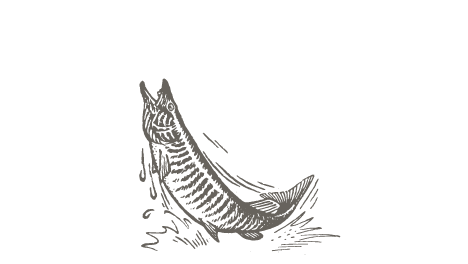Know the Rules (and When to Break Them) for Spring Musky on the Fly
The 14th Dalai Lama supposedly once advised that one “know the rules well so you can break them effectively.” While I doubt His Bodhic Holiness did much musky fly fishing (bet he’d have one hell of a zen strip set though, eh?) his advice here seems applicable when it comes to chasing spring muskies on the fly. Understanding the time-tested tactics and approaches to wrangle a springtime musky with a pile of fur, feathers, and tinsel certainly ups your odds of success. But to maximize your hook-up rates early in the season, be like “the Lama” and understand these “rules” well enough to know how to break them effectively.
As the season has started opening in earnest across the country, a picture is starting to emerge of the intersection of well-established tactics and freestyle running and gunning eliciting follows and eats. At the end of the day, muskies are mysterious, and musky fly fishers are rule breakers. Think of the following tactics as a great place to start targeting spring muskies, but trust what you’re seeing on the water, and don’t be afraid to roll the dice and deploy some unorthodox maneuvers to put early season esox in the net.
The Rules
There exists a set of age-old tactics and strategies for early season muskies which should serve as your starting point. The first and likely most ubiquitous of which is to size those patterns down. Cold water and the rigors of the spawn likely means muskies, while still eating, are going to maximize their return on investment while minimizing the energy expenditure required to do so. Wisdom has it that this means running smaller patterns to elicit an eat with a higher success rate and lower chance of fish wasting energy on escaped prey. For specificity’s sake, we’re talking about those single hook patterns in the 5-8 inch range. Small baitfish are starting to become more active at this time, and research has shown that muskies across the size range feed heavily on the smaller end of the body mass spectrum, so sizing down to meet a musky’s high-percentage prey size can up your odds of an eat.
In response again to colder water temps and potentially lethargic fish, prevalent wisdom tells us to slow the retrieve down. Fish who may indeed be triggered to eat by a baitfish burning through their hole will likely be reluctant to do so while metabolism and energy stores are taxed from the winter and the following spawn. In the early season, fish can often be triggered by a slow, but still erratic retrieve in which the angler maximizes the pause or “hang” to dangle their fly in the strike zone of potential muskies. Keep the retrieve varied and unpredictable, but allow your fly the time to do its beautiful, erratic dance on the pause.
Rounding out our trifecta of accepted and time-tested early season tactics, remember that muskies will likely be seeking out warmer water to jump start their metabolism and stage for their spawn. Because of this, seeking out shallow, sunlit areas with minimal current impact can put you onto fish at a higher rate than the deeper water haunts that hold fish later in the season. Look for quality structure within these shallow areas to increase your odds even more. Don’t be afraid to swap out that ultra fast sinking line for an intermediate or slow sink line when targeting these areas to reduce line snag on shallow structure.
Breaking The Rules
As mentioned before, the musky is truly a mysterious beast. The unpredictable, spontaneous nature of these fish and the ensuing chaos it can create is what pulled so many of us irresistibly into their orbit. It also means that understanding the prevailing tactics on how to catch them will only get you so far. While the tip of the musky fly fishing iceberg continues to grow as more innovation, research, and tactics emerge, the truth is that there is, and always will be, a massive element of this gig residing in the unknown. There are times when the best route from seemingly futile casting practice to celebrating a bagged fish requires bucking the trends and going rogue. Again, you’re a musky fly fisher, so I dare say this won’t be many deviations from your norm.
Early season reports from on the water are showing fish responding to XL patterns right now. If you’ve tried those 6-inch singles without any results, don’t be afraid to bust out your 12 weight and line up those mega gliders and articulated monsters you daydreamed of all winter long. We’re seeing fish respond to 10-14 inch patterns typically reserved for late fall right now, so don’t be afraid to stay dynamic and huck your most serious meat if the small stuff isn’t eliciting a response.
We’ve also seen success this spring by accelerating the retrieve on fish that show up. Despite the assumption of slow metabolism and lethargic fish, we’ve seen results with a consistently increasing retrieval speed, in one instance even approaching the strip saltwater style, increasing the speed of the retrieve with each subsequent strip.
Finally, common practice is to wait until the autumn leaves turn and temperatures drop to pull out those sucker patterns. However, many rivers across musky country have substantial sucker and redhorse runs in the spring. If you’ve been fishing standard baitfish patterns to no avail, a 6-10 inch sucker or redhorse fly stripped through warm shallow areas of structure can be successful in the spring as well as the fall.
At this point, you’re likely thinking to yourself, “this damned article is nothing but one giant contradiction.” No argument from the author there. Welcome to musky fly fishing! As with so many other elements of catching these fish on fly rods, the rules of early season fishing apply until, well, they don’t. Such is the beautiful mystery of muskies. Now that your season is either open or about to open wherever you are in musky country, get out on the water and deploy some of those trusted standby strategies for spring fishing. And, if/when those tactics and these stubborn fish have you feeling that pang of buyer’s remorse on the 2nd mortgage you took out to fund this obsession, give yourself permission to rage against the machine a little and switch things up. Knowing the rules, and how to break them effectively may just tip the needle in your favor and get you on the board early this spring.
-Tight lines!






Leave a comment